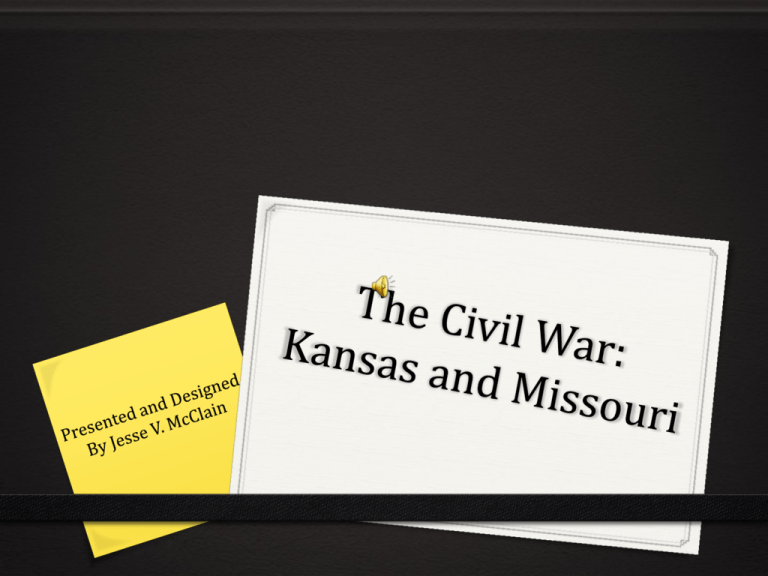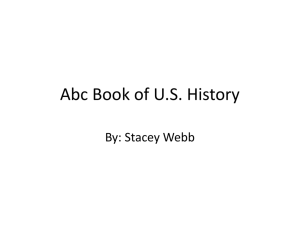Battle
advertisement

January 29, 1861 Became the 34th state to enter the Union. Kansas Most Kansans favored the cause of the Union. General Charles Robinson and Senator James H. Lane began to recruit Union troops. General Charles Robinson Senator James H. Lane Kansas-Start of the Civil War • The Federal Government asked Kansas for 16, 654 men, but over 20,000 enlisted. Kansas contributed 19 regiments and four batteries to the Union army. Kansas-Start of the Civil War • First major action for Kansas was during the Battle of Wilson’s Creek, on August 10, 1861. This battle involved both the First and Second Infantry regiments, and the First sustained heavy losses. Kansas-Civil War • In 1862, Kansas regiments served in campaigns in Tennessee, Kentucky, and Mississippi. Kansas-Civil War • James G. Blunt was the first Kansan to become majorgeneral and he fought in the battles of Rhea’s Mills, Cane Hill, and Prairie Grove. Kansas-Civil War • In 1862 and 1863, Kansas’s black and white regiments were used in Indian Territory. Kansas-Civil War • In Kansas served inthey the Vicksburg under General In 1863, 1863 at Chickamauga, served under General In 1863, they fought against the Morgan Raider’s in Indiana. Grant. Rosecrans. Kansas-Civil War • In 1864, most of the Kansas troops were stationed in Arkansas because there hadn’t been any been any real warfare in Kansas. In the fall of 1864, the Confederates attacked St. Louis but they never made it there and the battle took place in Kansas City. General Sterling Price of the Confederates tried to seize of Fort Scott and was defeated by the Union in the Battle of Mine Creek. Nearly 10,000 soldiers fought in this particular battle, and it became the largest battle fought on Kansas soil. Kansas-Civil War • The most devastating factor of the Civil War for Kansas was the raids and pillaging of guerrilla bands. The most distinguishable of these raids was on August 21, 1863. William Clark Quantrill and another few hundred followers raided Lawrence and by dawn the whole entire town was destroyed and 200 men were killed. Kansas-Civil War August 10, 1821 Became the 24th state to enter the Union During the Civil War, Missouri officially supported the Union, but because it was a border state, it had a lot of “brother against brother” battles. Missouri was the home of many northern and southern natives. 100,000 men enlisted for the Federal troops, while 50,000 men joined the Confederacy troops. While in Missouri, the Federal government was murdering innocent people, pillaging the property of the locals, as well as raping women and young children. Because of this, some of the Missourians started to help the Confederacy by giving them supplies and Union battle tactics, not because they supported what the South believed in, but because they disagreed with what the Federal government and army were doing in Missouri. During the war, because of all the terrible things that the Federal troops were doing to Missouri, a group of Missourians, called the Missouri Partisan Raiders formed an army to fight against the Union troops, therefore supporting the Confederacy. They supported the south because of a common enemy as opposed to a common cause for justice. 6,600 total battles were fought during the Civil War and out of those 6,600 battles, 1,100 of them were fought in Missouri. The vote for slavery in Kansas was taking place and Missouri, a slave state, wanted Kansas to be pro-slavery, and so thousands of Missouri residents crossed the border into Kansas and voted pro-slavery. There was extreme violence over the situation. There were now two governments in Kansas and both governments said that the other was illegal. 55 people were killed over slavery in the event known as “Bleeding Kansas.” Bleeding Kansas Missouri Compromise The Missouri Compromise was proposed in 1882. It said that all of the territory received from the Louisiana Purchase north of the 36 degree 36’ N latitude would be free and anything south of that line would be a slave state. It was ruled unconstitutional in 1857 during the Dred Scott Decision and was repealed during the Kansas-Nebraska Act in 1854. The Kansas-Nebraska Act was an act proposed by Stephen Douglas. It became law on May 30, 1854. The law allowed voters in the territories of Kansas and Nebraska to decide whether or not to allow slavery. It would repeal the slavery line set by the Missouri Compromise. The Kansas-Nebraska Act KANSAS-SLAVERY Slavery in Kansas was determined by popular sovereignty. Though many people tried to make the territory enter the Union as a slave state, Kansas wanted it to be anti-slavery. ? MISSOURI-SLAVERY Missouri was pro-slavery, but during the Civil War the state never seceded. MISSOURI-CIVIL WAR PEOPLE William Quantrill was a master of warfare who was part of the “guerillas.” He was probably the fiercest and most feared leader in the Civil War. He became the leader of the Quantrill’s Raiders. His best known raid was on August 21, 1863 where he led 450 raiders into Lawrence, Kansas. He was declared an outlaw by the Union and declared a captain by the Confederacy. To his supporters, he was “a dashing, free-spirited hero.” William Quantrill MISSOURI-CIVIL WAR PEOPLE William Quantrill was killed eventually in a raid in Kentucky in 1865. William Quantrill cont. Members of Frank James’s Gang Frank James was a member of the Quantrill raids and supported the Confederacy during the Civil War. After the raid in Lawrence, Kansas, Frank became an outlaw and so he formed a gang that involved Bob Younger, Cole Younger, Bill Chadwell, Clell Miller, and Charlie Pitts. FRANK JAMES On October 5, 1882, Frank James gave himself up to the authorities and he admitted all of the crimes that he had committed. MISSOURI-CIVIL WAR PEOPLE Cole Younger was a member of both the guerilla raids and a part of the JamesYounger gang. Cole Younger fought for the Confederacy in the Civil War and eventually became an outlaw for his tyranny. Cole survived the Civil War and died on March 21, 1916. Cole Younger MISSOURI-CIVIL WAR PEOPLE William Anderson, nicknamed “Bloody Bill,” was a part of Quantrill’s raids. He fought for the Confederacy and joined a group called the “bushwhackers” when he was forced from his state. The “bushwhackers” would often times wear Union uniforms to get inside information on the North’s warfare tactics. Fear of “Bloody Bill” raged throughout Missouri. William “Bloody Bill” Anderson MISSOURI-CIVIL WAR PEOPLE Bloody Bill and his group of about 80 or so followers were notoriously known for decorating the saddles of their horses with scalps of their dead enemies. When his sister was killed in prison, Bloody Bill became crazy with rage. He would charge onto battle fields and torture soldiers by cutting off their ears. William “Bloody Bill” Anderson cont. Gabriel Rene Paul-Missouri Gabriel Rene Paul was a general for the Union Army during the Civil War. He fought during the Battle of Chancellorsville and the Battle of Gettysburg. During the Battle of Gettysburg, he was seriously wounded and left blind and with a very bad sense of hearing and smell. Frederick Schaefer-Missouri Frederick Schaefer was an immigrant from Germany who served the Union army as a colonel during the Civil War. He served in the 2nd Missouri Infantry and fought in the Battle of Pea Ridge, the Battle of Stones River, and the Siege of Corinth. Frederick was killed in action during the Battle of Stones River. Charles W. Blair-Kansas Charles Blair was a brigadier general who served for the Union army in 3 different Kansas regiments, the 2nd Kansas Infantry, the 2nd Kansas Cavalry, and the 14th Kansas Cavalry. He fought in many battles, such as The Battle of Wilson’s Creek, the First Battle of Newtonia, the Battle of Westport, and the Battle of Mine Creek. Charles survived the war and died in 1899. Caleb Pratt-Kansas Caleb Pratt was a Second Lieutenant who served in the Union Army. Caleb joined the army in 1861 as a Company D, Kansas 1st Infantry Regiment. The first battle that he fought in was the Battle of Wilson’s Creek where he was shot and killed. William Weer-Kansas William Weer served in the Union Army and is noted for his actions at the Trans-Mississippi Theatre. Prior to the war, Weer was an attorney general for Kansas, and then joined the Kansas regiment. He fought in the Battle of Locust Grove, the First Battle of Newtonia, the Battle of Old Fort Wayne, the Battle of Cane Hill, the Battle of Prairie Grove, and the Battle of Westport. He was dismissed from the army after a court-martial. John Poindexter-Missouri John Poindexter was a colonel during the Civil War for the Confederate Army. He fought in many battles such as the Siege of Lexington, Battle of Roan’s Tan Yard, Battle of Pea Ridge and Battle of Compton’s Ferry. On September 1st, Poindexter was captured by the Union. He was tried for being a “guerilla” but was found not guilty. However he received threats from the Unionists who called him a bushwhacker and the Confederates who considered him a traitor. Poindexter died of poor health on April 14, 1869. James Cunningham-Missouri James Cunningham was a soldier who served during the Civil War for the Union Army. He was a Private who served in the regiment Company D, 8th Missouri Infantry. He participated in the Siege of Vicksburg, where he was one of 79 survivors who was awarded a Medal of Honor for gallantry. John Noland-Kansas John Noland was a black man who fought for the Confederacy. He sometimes followed William Quantrill on his raids. By the other raiders, John was described as “a man among men.” Kansas during the Civil War mostly supported the Union. Missouri during the Civil War was extremely divided between the Union and the Confederacy. Some important events that took place during or may have helped to trigger the Civil War were the Missouri Compromise, Bleeding Kansas, the Kansas-Nebraska Act, and slavery. During the Civil War, Kansas was anti-slavery and Missouri was pro-slavery. A group of people called Quantrill’s Raiders and the James-Younger gang raided towns and used violence to support the Confederacy. Many people fought for both the Confederacy and the Union Armies during the Civil War, and many were shot and killed, but all believed what they were fighting for. Conclusion THE UNION WINS THE CIVIL WAR!!!!






